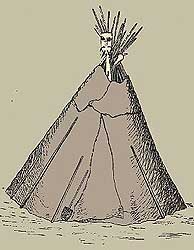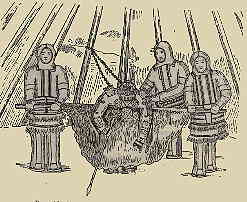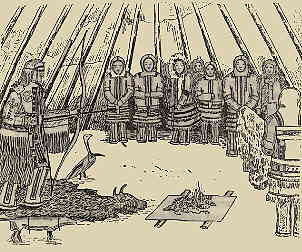The Clean Tent Rite
After the end of the polar night the clean tent rite was performed by the Nganasan shamans. Only a great shaman, who has helping spirits enough for the long journey, could accomplish 3, 5, 7 or 9 days lasting ceremony. A cpecial tent was pitched for the rite. New tent poles were made, seven ones for each day of the rite. So if the rite lasted seven days there must have been 49 poles in the framework of the clean tent. Three dusky reindeer were sacrified, their heads, legs and hides were hung round the top of the tent. Tent covers were smeared with the blood.

The clean
tent. Drawing from A.
Popov's book "Tavgitsy" (Moskva-Leningrad 1936).
On January 1931, A. Popov observed seven days lasted clean tent rite organised by Avam river Nganasans. Dyukhade Kosterkin played the leading role in this rite. On the first day the shaman had to attain the clean tent blindfold. He began to shamanise in his own tent, singing the incantation addressed to the Lord of the hearth. Then he was blindfolded with special tie and guided out of the tent where he was turned round several times. Nevertheless, Dyukhade found the right orientation at once and started to go towards the clean tent. Then some attemts to sidetrack the shaman from his way were taken on by onlookers. Two men drew a rope across the way of Dyukhade. The shaman stopped just in front of it and proceeded only after the rope was removed. A man with a club in his hands crept up on shaman and imitated hitting. Dyukhade swerved as to avoid the hit. He reached the clean tent and found the entrance. After Dyukhade all spectators entered the tent. The tie was removed from shaman's eyes. Dyukhade began to sing his incantations, now addressed to his helping spirits. He asked them to protect everyone who was present in the rite. The first day of the rite was the stepping to the clean ground. On that day the shaman did not ascend to the sky, he only travelled in the middle world. The day ended with dance: the shaman began to sing a wordless song, and all stood in circle, holding hands with each other and stamping. While dancing the women imitated sounds of she-reindeer being on heat.

Dyukhade is
shamanising in the clean tent. Drawing from A. Popov's book
"Tavgitsy".
On the next day Dyukhade shamanised in the clean tent. He had a wooden image of ermine on his right hand and a wooden image of a bird on his left hand. Both symbolised his chief helping spirits during that rite. Following them, the shaman ascended to the second level of the heaven where a deity named Luonkari barba was living. From Luonkari barba Dyukhade asked fortunate next year for everybody and painless childbirth for all women. The deity bade him to show his capability. Dyukhade put his overturned drum in the lap of a spectator. Across the drum he placed a special leather strap with a copper button in its one end (symbol of the umbilical cord), and went out of the tent. An other spectator took the strap, hid it inside his coat, went back and forth in the tent for foiling his tracks, and sat down on his former place. After that the shaman entered. He went directly to his drum, beat it several times, and listened, closing his ear up the drum skin. Then he started to track like the dog, following exactly the trail of the man who had hidden the strap. In front of the latter he stopped, and beat his drum three times.
On the third day Dyukhade ascended to a deity he asked from the year without diseases. The deity bade him look up a cord with four branches. If the shaman is capable of finding the cord, next year will be without serious illnesses. Then Dyukhade took the cord and a small bag, and handed them to the spectators. All went in the other tent, leaving the shaman alone. The small bag was opened. There were five pieces of cloth in the bag: a towel for the Spirit of the tumour, a red shawl for the Spirit of the haemorrhage, a black band for the Spirit of the "black sickness" (smallpox), a gray piece of cloth for the Spirit of the cough, and a white band for the Spirit of the headache. The cord was wrapped in one of these pieces of cloth, all other pieces were also bundled up and put in the bag. Then all went back to the clean tent where the bundles were placed on the drum. Dyukhade did not touch them, he only smelled the bundles and pointed to one with the cord in it.
On the fourth day Dyukhade proceeded his ascending. He met a deity he asked from sense and truthfulness for children who will born during next year. Another band was hidden and the shaman found it. On the fifth day Dyukhade had to pass the dwelling of the most dreadful deity Tuyo nguo. When he was close to the dwelling, he put his drum aside and went out of the tent. A circle was made up by fifteen persons. Together with the shaman they made in silence three turns clockwise. In this manner they protected the shaman and themselves from the evil deity. On the sixth day Dyukhade reached the dwelling of Tuy koca, the deity who sends several diseases after the childbirth. While shamanising, five women sat down next to shaman. Dyukhade asked the deity not to torture women, but Tuy koca demanded bad childbirth for five women. Dyukhade pointed to the women sitting beside him and said, "What are you going to do? There are only five women among my people. How can people multiply if all women will die?" Then Tuy koca bade him look up another cord, and Dyukhade found it without any difficulties.
On the seventh day Dyukhade reached the highest level of the sky. A long pole was erected in the middle of the tent. The shaman climbed up and poked his head out of the smoke-vent. The pole symbolised the tree, rising in the centre of the highest sky level. On the top of the tree a spotty face deity was living. The shaman complained him about a multitude of diseases in the human world. "Is all my people doomed or is there any hope for them yet?" he asked. The deity said, "Look round. If a bad year is coming, you can't see the horizon in thick mist. But if a good year is coming, the horizon is perfectly visible and shines in the sunlight." Dyukhade climbed down and said that he had seen the shining horizon.

Dyukhade is swimming
across the Sea of the dead. Drawing from A. Popov's book
"Tavgitsy".
Then another pole was brought in the tent. On the pole a polar bear hide was hung. Two men held the pole, and Dyukhade leant on it. He moved his arms like he was swimming, and imitated sounds of the bear. All stood in silence. They knew that the shaman in the shape of the polar bear was swimming across the Sea of the dead, and with him the souls of the spectators like the foam were floating. They also knew that the souls of the people doomed to die during next year could not win the shore. While swimming, Dyukhade said that three souls had left him, and all expressed their sorrow. After swimming lasted an hour, the shaman jumped over the pole and said, "Bad things I had not seen during my successful journey. You have now to strip off the covers of this tent."

Dyukhade
is shooting at the reindeer hide in the clean tent.
Drawing from A. Popov's book "Tavgitsy".
After that two men stood each on the other side of the entrance. They held a pole with the reindeer hide hanging on it. Before the clean tent rite Dyukhade had told the hunters to kill such-and-such reindeer and give the hide to him. Now the blindfolded shaman took a bow and shot the hide. He hit the hide with his first arrow, showing in this manner that next year would be good for reindeer hunters. Then Dyukhade's wives and daughters brought several bags filled with meat and fat pieces. The shaman divided all the meat except two or three last handfuls between spectators. These last handfuls he threw up, and everybody tried to catch some pieces for good luck. Then Dyukhade went back to his own tent where he thanked the Lord of the hearth for his help and asked him to protect everyone who was present in the rite.
Abbreviately from A. Popov, "Tavgitsy". Moskva-Leningrad 1936, pp. 63-79.
Back to the Shamans from Kosterkin Family page